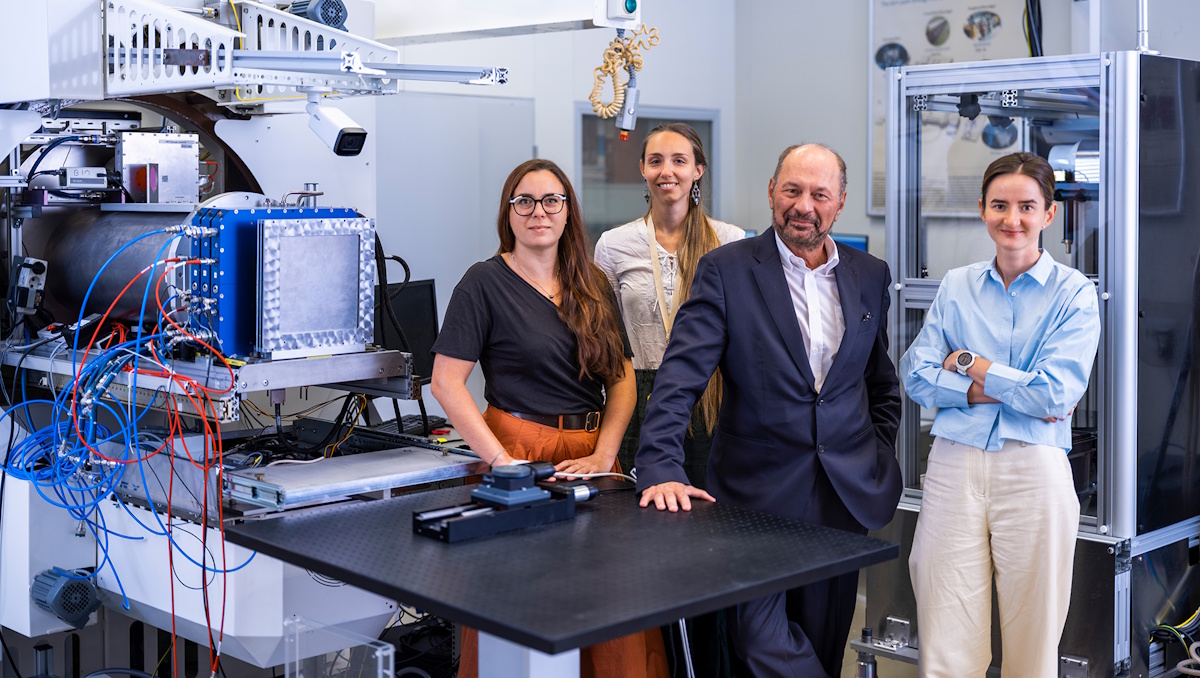Science
German Researchers Pioneer Radioactive Ion Beam Cancer Treatment

Researchers in Germany have successfully conducted the first cancer treatment using a radioactive carbon ion beam, specifically 11C, on a mouse with a bone tumour located near the spine. This innovative approach combines particle therapy with advanced imaging techniques, allowing for simultaneous treatment and visualization of the treatment beam within the body.
Particle therapy, which employs beams of protons or heavy ions, is known for its effectiveness in treating cancer due to its precise targeting capabilities. The method leverages the Bragg peak phenomenon, which allows for highly conformal tumour targeting. However, the technique is sensitive to range uncertainties that can affect the accuracy of the Bragg peak position. To address these challenges, the research team suggests utilizing positron emission tomography (PET) to track isotopes produced when the treatment beam interacts with bodily tissues.
Currently, carbon ion therapy is performed at 17 centres worldwide, utilizing the detection of beta decay from 10C and 11C fragments. These fragments, however, produce weak PET signals, complicating accurate treatment delivery. The researchers involved in the ERC-funded BARB (Biomedical Applications of Radioactive ion Beams) project propose that using positron-emitting ions like 11C can enhance treatment effectiveness by generating significantly stronger PET signals and improving the localization of the ion beam during therapy.
“Range uncertainty remains the main problem of particle therapy, as we do not know exactly where the Bragg peak is,” stated Marco Durante, head of biophysics at the GSI Helmholtz Centre for Heavy Ion Research and principal investigator of the BARB project. “If we ‘aim-and-shoot’ using a radioactive beam and PET imaging, we can see where the beam is and can then correct it. By doing this, we can reduce the margins around the target that spoil the precision of particle therapy.”
Innovative In Vivo Experiments
To validate their hypothesis, Durante and his team conducted in vivo experiments at the GSI/FAIR accelerator facility in Darmstadt. They employed a portable small-animal in-beam PET scanner, developed by Katia Parodi and her team at LMU Munich. This scanner, originally designed for the ERC project SIRMIO, features 56 depth-of-interaction detectors, enabling real-time monitoring of activity during irradiation.
“Not only does our spherical in-beam PET scanner offer unprecedented sensitivity and spatial resolution, but it also enables on-the-fly monitoring of the activity implantation for direct feedback during irradiation,” remarked Parodi, co-principal investigator of the BARB project.
In their study, the researchers treated 32 mice with osteosarcoma tumours implanted near the spinal cord using a radioactive 11C-ion beam produced at the GSI fragment separator. They utilized a range modulator to create a spread-out Bragg peak (SOBP) and a plastic compensator collar for positioning the mice during treatment. The anaesthetized mice were positioned vertically inside the PET scanner and received doses of either 20 Gy or 5 Gy at a rate of approximately 1 Gy/min.
The team compared measured activity levels with Monte Carlo-simulated activity derived from pre-treatment microCT scans. They noted that activity distributions were shifted by roughly 1 mm, attributed to anatomical changes between the scans and the treatment positioning. After adjusting for this shift, the simulation results aligned closely with the measured activity.
“Our findings reinforce the necessity of vertical CT planning and highlight the potential of online PET as a valuable tool for upright particle therapy,” the researchers concluded.
With the tumour located near the spine, even minor range uncertainties could potentially harm spinal cord tissues. The online PET imaging during irradiation confirmed that the SOBP did not encroach on the spinal cord, allowing for safe treatment. Following the irradiation, assessments for signs of radiation-induced myelopathy revealed no severe toxicity in any of the mice, further indicating the safety of the procedure.
Future Directions in Particle Therapy
Following the promising results, the researchers investigated the washout rate of the radioactive signal from the tumour. This included both a slow decrease due to the decay of 11C (which has a half-life of 20.34 minutes) and a faster decline related to blood flow removing the isotopes. The results indicated that washout was dose-dependent; the rapid component was evident at 5 Gy but diminished at 20 Gy.
Durante posited, “If this is true, high-dose radiotherapy may work in a completely different way from conventional radiotherapy: rather than killing all the cancer stem cells, we just starve the tumour by damaging the blood vessels.”
The team plans to explore treatment with 10C or 15O beams, which are anticipated to yield stronger signals and enhanced temporal resolution. A new Super-FRS fragment separator at the FAIR accelerator facility will facilitate the high-intensity beams required for these investigations.
As the research progresses, the team acknowledges the need for a cost-effective clinical design. “CERN has proposed a design [the MEDICIS-Promed project] based on ISOL [isotope separation online] that can be used as a source of radioactive beams in current accelerators,” Durante told Physics World. “At GSI, we are also working on a possible in-flight device for medical accelerators.”
These groundbreaking findings are detailed in the journal Nature Physics, marking a significant advancement in cancer treatment methodologies.
-

 Entertainment2 months ago
Entertainment2 months agoAnn Ming Reflects on ITV’s ‘I Fought the Law’ Drama
-

 Entertainment3 months ago
Entertainment3 months agoKate Garraway Sells £2 Million Home Amid Financial Struggles
-

 Entertainment2 months ago
Entertainment2 months agoCoronation Street’s Carl Webster Faces Trouble with New Affairs
-

 Health1 month ago
Health1 month agoKatie Price Faces New Health Concerns After Cancer Symptoms Resurface
-

 Entertainment1 month ago
Entertainment1 month agoWhere is Tinder Swindler Simon Leviev? Latest Updates Revealed
-

 Entertainment3 months ago
Entertainment3 months agoKim Cattrall Posts Cryptic Message After HBO’s Sequel Cancellation
-

 Entertainment2 months ago
Entertainment2 months agoMasterChef Faces Turmoil as Tom Kerridge Withdraws from Hosting Role
-

 Entertainment3 months ago
Entertainment3 months agoSpeculation Surrounds Home and Away as Cast Departures Mount
-

 World1 month ago
World1 month agoCole Palmer’s Mysterious Message to Kobbie Mainoo Sparks Speculation
-

 Entertainment2 months ago
Entertainment2 months agoITV’s I Fought the Law: Unraveling the True Story Behind the Drama
-

 Entertainment1 month ago
Entertainment1 month agoCaz Crowned Winner of The Great British Sewing Bee, Overjoyed by Triumph
-

 Entertainment3 months ago
Entertainment3 months agoMarkiplier Addresses AI Controversy During Livestream Response





















